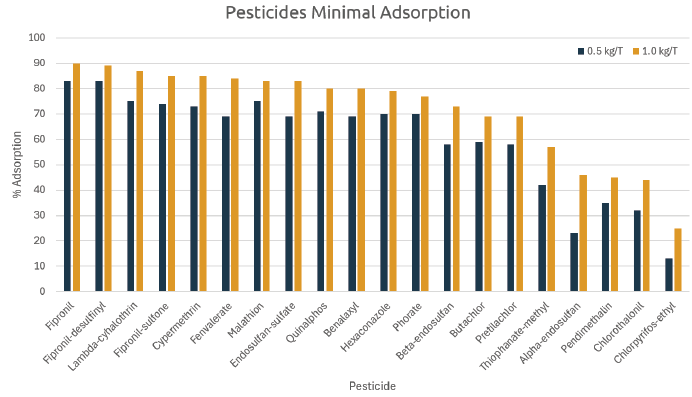By Josep Garcia-Sirera, Category specialist toxinbinders
Today´s animal production faces many challenges from different types of toxins. Toxins can originate from fungi (mycotoxins), bacteria (endotoxins and exotoxins), and chemicals (pesticides, heavy metals, and drug residues). Pesticides in animal feed are a concern because they can affect animal health, food safety, and the environment. The different kinds of pesticides – such as herbicides, insecticides, and fungicides – can enter animal feed through the crops used in feed production, either by direct application or from residues left on the crops during cultivation.
The effects on the animals depend on the level of exposure, but all of the different exposure levels will eventually result in altering production parameters in addition to animal health. Based on toxicity, they can be classified as follows:
- Acute Toxicity: High levels of pesticide residues can cause poisoning, affecting vital organs and leading to symptoms like muscle tremors, difficulty breathing, and even death in severe cases.
- Chronic Exposure: Long-term exposure to lower levels can cause issues like weakened immune systems, reduced reproductive efficiency, and developmental problems in animals.
- Bioaccumulation: Pesticides can accumulate in the fat tissues of animals, leading to potential health risks over time.
Pesticides in feed form both an animal health issue (due to the effects mentioned above) and a food safety issue: pesticides ingested by animals can be transferred to meat, milk and eggs. Human consumption of pesticide residues through animal products can then lead to health issues.
Binding capacity of Mycoad AZ
Various approaches have been tested to reduce the effects of toxins in animal production. One of the more practical and cost-effective approaches is to bind the toxin in the gastrointestinal tract so that it is not absorbed. The bound toxin is then eliminated in the feces. Different toxin binders have been tested to show their ability to bind mycotoxins, with varying results. Very few scientific tests report toxin binders showing a binding capacity for other toxins, such as bacterial toxins and/or pesticides in feed.
Royal Agrifirm Group tested its special bentonite against different pesticide molecules to determine its capacity to bind them. The molecules were selected from 3 different classes of pesticides: 13 insecticides, 4 herbicides, and 3 fungicides. The main focus was on insecticides, because the potential toxic effects of insecticide residues on animals are, in general, greater compared to the 2 other classes of pesticides: because insecticides have higher toxicity, they cause greater health concerns than other pesticides.
A further selection was made within each pesticide class – taking their relative importance on a global scale into account, the most important chemical families within each class of pesticides is represented by at least 1 active molecule. For example, within the class of insecticides, 3 different families (organochlorides, organophosphates, pyrethroids) are represented in the test. In total, 20 active compounds were tested.
The adsorption efficiency, or binding capacity, of the bentonite was measured by analyzing the concentration of pesticides in the extracts before and after co-incubation with the binder, similar to standard testing for mycotoxin binders. The adsorption capacity was measured at 2 different dosages of the product (equivalent to 0.5 kg/T and 1.0 kg/T) and 2 different pH values (pH=3 and pH=6). The 2 pH values were selected because they are similar to lower and higher pH values in the stomach and gastrointestinal tract of production animals.
Aqueous buffer (with or without adsorbent) was spiked with a cocktail of 20 active pesticide molecules (each at a concentration of 1000 μg/L or 1 ppm) and was analyzed using the following protocol:
- suspending the binder in buffer solution (pH=3 or pH=6)
- adding the pesticidal compounds to the binder/buffer blend
- allowing time for adsorption (3 hours)
- injecting the supernatant into the chromatograph
A solution containing 1ppm of each of the 20 pesticides, without binder, was taken as the reference solution. The percent of adsorption was then calculated from the concentration remaining in solution after incubation and compared to the concentration in the reference solution without binder.
Irreversible binding of the pesticide
The results showed that the binder is able to adsorb (bind) a wide range of pesticide molecules, and the absorption is largely independent of pH. This likely translates into an irreversible binding of the pesticide throughout the animals’ intestinal tract, as pH is known to have a major impact on pesticide and mycotoxin binding by clay minerals. In practice, this would mean that, once the bentonite binds the pesticide molecule in the gastrointestinal tract, there would be no release during the transit through the intestine because of the change of pH.
The graph below shows the minimal binding capacity of each pesticide at the 2 different dosages:

Mycoad AZ, an excellent all-around binder
This trial clearly shows the capacity of Royal Agrifirm Group’s bentonite to bind different pesticide molecules at low inclusion rates. In addition to the ability to bind different mycotoxins and endotoxins, as demonstrated in previous tests, the pesticide-binding capacity shown in this trial makes our bentonite an excellent all-around binder for the toxins most potentially present in feed.